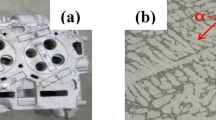Abstract
A comprehensive study has been carried out on a 7075-T651 alloy to examine the influence of water vapor on fatigue crack growth. The kinetics of fatigue crack growth were determined as a function of water vapor pressure at room temperature and at 353 K. Detailed fractographic analyses and surface chemistry studies were carried out to identify the micromechanisms and to quantify the chemical interactions for corrosion fatigue crack growth in this alloy. Experiments were also carried out in ultra-high vacuum and in oxygen to provide for comparisons. Two regions of fatigue crack growth response were identified. In the low pressure region (below 67 Pa at 5 Hz), crack growth is controlled by the rate of transport of water vapor to the crack tip, and the response can be described by a model for transport controlled crack growth. At pressures above 67 Pa, additional increases in crack growth rate occurred, which are attributed to the further reactions of water vapor with segregated magnesium in this alloy. Different micromechanisms for crack growth have been identified for vacuum, oxygen, and water vapor. These micromechanisms are considered in relation to the environmental parameters through a modified superposition model for corrosion fatigue.
Similar content being viewed by others
References
R.P. Wei, P.S. Pao, R.G. Hart, T.W. Weir, and G.W. Simmons:Metall. Trans. A, 1980, vol. 11A, pp. 151–58.
T.H. Shih and R.P. Wei:Engr. Fract. Mech., 1983, vol. 18, pp. 827–37.
T.W. Weir, G.W. Simmons, R.G. Hart, and R.P. Wei:Scripta Metall, 1980, vol. 14, pp. 357–64.
R.P. Wei and G.W. Simmons:Intl. J. Fract. Mech., 1981, vol. 17, pp. 235–47.
R.P. Wei and G.W. Simmons: in FATIGUE:Environment and Temperature Effects, John J. Burke and Volker Weiss, eds., Sagamore Army Materials Research Conference Proceedings, 1983, vol. 27, pp. 59-70.
R. Brazill, G. W. Simmons, and R. P. Wei:J. Engr. Math. & Tech., 1979, vol. 101, pp. 199–204.
P. S. Pao, W. Wei, and R. P. Wei: inEnvironment-Sensitive Fracture of Engineering Materials, Z. A. Foroulis, ed., TMS-AIME, 1979, pp. 565-80.
F.J. Bradshaw and C. Wheeler:Intl. J. Fract. Mech., 1969, vol. 5, pp. 255–68.
A. Hartman, F. J. Jacobs, A. Nederveen, and R. DeRijk: NLR Tech. Note No. M2181, National Aerospace Laboratory, Amsterdam, The Netherlands, 1967.
ASTM E647-81, Standard Test Method for Constant-Load Amplitude Fatigue Crack Growth Rates Above 10−8m/cycle.
H.H. Johnson:Mater. Res. Stand., 1965, vol. 5, pp. 442–45.
Che-Yu Li and R.P. Wei:Mater. Res. Stand., 1966, vol. 6, pp. 392–94.
R. P. Wei and R. L. Brazill: inFatigue Crack Growth Measurement and Data Analysis, ASTM STP 738, S.J. Hudak and R.J. Bucci, eds., Am. Soc. Testing Mater., 1981, pp. 103-19.
R. M. N. Pelloux:Trans. Am. Soc. Metals, 1969, vol. 62, pp. 281–85.
W.G.C ark, Jr. and S.J. Hudak,Jr. :J. Testing Eval., 1975, vol. 3, pp. 454–76.
R. P. Wei, W. Wei, and G. A. Miller:J. Testing Eval., 1979, vol. 7, pp. 90–95.
Dennis L. Dicus: in Environment-Sensitive Fracture, ASTM STP 821, S. W. Dean, E.N. Pugh, and G.M. Ugiansky, eds.,Am. Soc. Testing Mater., 1984, pp. 513-33.
R. P. Wei, Ming Gao, and P. S. Pao:Scripta Metall., 1984, vol. 18, pp. 1195–98.
Ming Gao, P.S. Pao, and R.P. Wei: inFracture: Interactions of Microstructure, Mechanisms and Mechanics, J. M. Wells and J. D. Landes, eds., The Metallurgical Soc. of AIME, Warrendale, PA 15086, 1985, pp. 303–19.
J. Lankford and D.L. Davidson:Acta Metall., 1983, pp. 1273-84.
B. Tomkins and W. D. Biggs:J. Mater. Sci., 1969, vol. 4, pp. 544–53.
C. Q. Bowles and J. Schijve: inFatigue Mechanisms: Advances in Quantitative Measurements of Physical Damage, ASTM STP 811, J. Lankford, D.L. Davidson, W.L. Morris, and R.P. Wei, eds., Am. Soc. Testing Mater., 1983, pp. 400-26.
K.J. Nix and H.M. Flower:Acta Metall, 1982, vol. 30, pp. 1549–59.
R. P. Wei and P. S. Pao: Technical Report No. 2, Air Force Office of Scientific Research, 1983.
C.Q. Bowles and D. Broek:Intl. J. Fract. Mech., 1972, vol. 8, pp. 75–85.
L.E. Davis, N.C. MacDonald, P.W. Palmberg, G.E. Riach, and R. E. Weber:Handbook of Auger Spectroscopy, Physical Electronics Industries, Inc., 1976.
R. P. Wei: inFatigue Mechanisms, ASTM STP 675, J. T. Fong, ed., Am. Soc. Testing Mater., 1979, pp. 816-40.
R.P. Wei: 21-24 Oct., 1985, Xi’an, People’s Republic of China, E.M.A.S., Warley, England.
R. P. Wei and Ming Gao:Scripta Metall., 1983, vol. 17, pp. 959–62.
J.C. Fuggle, L.M. Watson, D.J. Fabian, and S. Affrossman:Surf. Sci., 1975, vol. 49, pp. 61–76.
Author information
Authors and Affiliations
Rights and permissions
About this article
Cite this article
Gao, M., Wei, R.P. & Pao, P.S. Chemical and metallurgical aspects of environmentally assisted fatigue crack growth in 7075-T651 aluminum alloy. Metall Trans A 19, 1739–1750 (1988). https://doi.org/10.1007/BF02645142
Received:
Issue Date:
DOI: https://doi.org/10.1007/BF02645142




